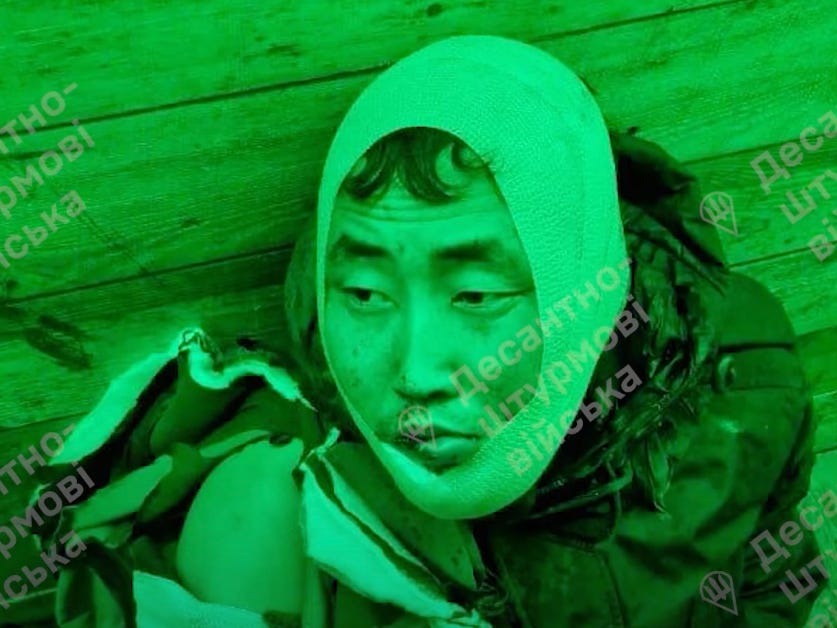-
Ukrainian paratroopers said a North Korean soldier they captured ran into a pillar to knock himself out.
-
They said they found him alone on the battlefield with a grenade, a knife, and some food.
-
Their prisoner closely resembles one of the two North Koreans Ukraine said it captured.
Ukrainian paratroopers in Kursk said they captured a North Korean soldier who tried so hard to evade capture that he intentionally ran into a concrete pillar to knock himself out.
Three members of the 95th Separate Air Assault Polissia Brigade spoke of the encounter in a video published on Tuesday, describing how one of their drones found a lone North Korean on the battlefield after an assault had ended.
The clip was published by the brigade’s press service on its YouTube, Facebook, and Telegram accounts.
The paratroopers said they enveloped the North Korean with guidance from drone operators and found that he didn’t respond to commands in Ukrainian, Russian, or English.
“With gestures, we showed him what to do,” one of the paratroopers said.
The soldier was carrying a grenade, a knife, and a sausage, the paratroopers said.
They said the North Korean was also visibly wounded, with his jaw bandaged and one of his hands appearing to be injured.
One paratrooper said the injured soldier appeared calm at first but grew agitated when he saw a vehicle coming to pick him up.
“When we brought him near the road, suddenly he ran headfirst into a concrete pillar at full speed. He hit it very hard and probably passed out,” he said.
But the paratrooper also suspects it might have been a ploy by the North Korean soldier, because the latter fell backward, not forward, as one might expect when a charging person faints.
“I think he was faking it, trying to get us close so he could grab a weapon and attack us,” he said.
The paratroopers said they eventually hauled the North Korean into a vehicle and took him away from the front lines, after which he received food and watched romance films upon request.
An older paratrooper said in the video that the North Koreans’ tactics appeared to mimic Russia’s Soviet-era fighting, with frontal assaults where “they try to crush simply with massive numbers.”
But he added that while Russian forces in Kursk tend to attack in groups of two or three, the North Koreans would conduct assaults with groups of at least six.
The paratroopers said that Pyongyang’s forces would fight to the end if cornered, adding that their brigade reported instances where wounded North Koreans blew themselves up to avoid capture.
“They are not in a mood to surrender,” one of the paratroopers said.
The man they captured appears to be one of two North Korean soldiers whom Ukrainian President Volodymyr Zelenskyy announced had been seized from the battlefield in early January.

One of the North Korean soldiers presented by Zelenskyy closely resembles the man seen in the video posted by the paratroopers.Ukrainian President Volodymyr Zelenskyy’s Social Media / Handout/Anadolu via Getty Images
One was captured by Ukraine’s special forces, while the other was found by the Polissia brigade.
The paratroopers posted a clip of their prisoner on January 11, which they referenced when recounting the events of his capture in their Tuesday video.
Another North Korean soldier, separate from the pair shown by Zelenskyy, was captured in December, but South Korea’s intelligence service said he died of his injuries shortly after.
Western and South Korean intelligence estimate that 12,000 North Korean soldiers have been sent to Russia, where they’ve been deployed to fight a Ukrainian incursion in the Kursk region.
Their presence in the war is a significant sign of Pyongyang and Moscow strengthening an economic and military partnership spurred by Russia’s isolation since the war began.
North Korean leader Kim Jong-un is believed to have received food, financial assistance, and Russian expertise in space and weapons technologies in return for his troops and guns.
Meanwhile, the West fears that North Korean troops are gaining valuable combat experience from fighting in Russia.
A captured North Korean soldier’s documents obtained by The Washington Post discusses guidance related to the six-man frontal assaults the paratroopers spoke of.
“In modern warfare, where real-time reconnaissance and drone strikes are conducted, failing to disperse combat teams into smaller units of two to three members could lead to significant casualties from enemy drones and artillery,” one document read, per The Post.
Read the original article on Business Insider

